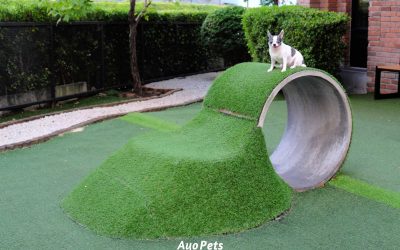I have a mixed breed dog that loves lying in the hot sun every day. She lies there panting away, before taking a dip in the kiddie pool or moving to the shade for a while. I often watch her and wonder why she wants to get so hot in the sun like that. So, I did some digging to find out why dogs love to sunbathe…
Dogs love sunbathing because it feels great and releases feel-good hormones. Sunshine also helps keep dogs healthy and sleep better. Dogs need sunshine at different times of day to get all the benefits of sunbathing. But it’s important to monitor dogs with short snouts, sparse fur and pink skin in the sun, as they are more vulnerable to sunburn and heat exhaustion.
The truth is your dog will be pretty good at getting all the sunshine he needs, if he has access to a sunny spot and a place to cool down in between. If your dog loves lying in the sun, make sure there’s plenty of cool, fresh water available and shade.
Why dogs love lying in the sun
Let’s take a look at 7 of the biggest reasons why your dog loves sunbathing:
1. Dogs get some Vitamin D from the sun
Vitamin D is important for healthy teeth, bones, nerves, and muscles in the body. We all need Vitamin D but dogs, like us, can’t make this vitamin on their own.
Dogs get most of this vitamin from the food they eat. They get the rest from sunshine in an amazing way:
- Dogs release an oily cholesterol from their skin
- This oil turns to Vitamin D when exposed to sunlight
- Because of their fur, a dog’s skin can’t absorb this oil so the oil stays on the fur
- When a dog licks and grooms itself, it is taking in the Vitamin D on its fur
2. Dogs feel happier after sunbathing
Sunlight triggers the brain to make a hormone called serotonin. Serotonin is known as the ‘happiness hormone’ for good reason – it makes you feel happier, calmer and more relaxed.
A dog lying in the sun produces serotonin and feels all these wonderful things, which is one of the reasons why they enjoy sunbathing so much.
But serotonin helps the body with many other things:
- Serotonin is found in the stomach and intestines, where it helps keep the bowel healthy and working well
- Serotonin helps your dog sleep well
- Serotonin keeps the bones strong
- Serotonin helps the arteries form blood clots, which makes your dog heal faster when there is a wound
3. The sun kills microorganisms on the skin
Ultraviolet light in the sun’s rays kill bacteria and other microorganisms.
One study found that letting daylight into a room can kill about 93% of bacteria living in the dust there.
Dogs love lying in the sun because the sun’s rays are a natural disinfectant for them – killing unhealthy bacteria or microbes on their skin and keeping them healthy.
4. The sun helps dogs stay warm and save energy
Basal body temperature is how hot or cold you are when you are resting: sitting or lying down and not moving around much.
A dog’s natural basal temperature is 101 to 102.5 degrees Fahrenheit (38.3 to 39.2 degrees Celsius), which is a bit higher than humans at 98.6 degrees Fahrenheit (37 degrees Celsius).
If they’re already hotter than us, why do dogs want to lie in the hot sun?
Because lying in the sun helps them keep their basal temperature high enough and save energy at the same time, especially in colder months.
If dogs lie in the sun they don’t have to run around to stay warm. And if they’re warm enough, they get to relax and enjoy the rest
5. The sun relieves joint pain
It is estimated that one in five dogs will get arthritis. Dogs that are old or overweight are more likely to get this disease.
Arthritis attacks the cartilage in a dog’s joints, which is there to help the bones move together smoothly. When the cartilage changes or is damaged, the bones rub together directly without the soft cartilage cushioning, which causes the dog pain.
Dogs can feel this pain in one or more joints in their back, shoulders, hips, legs, or feet.
Sunbathing warms up the dog’s body and increases blood flow to the tissues, which relieves some of the pain from arthritis and general joint pain.
6. The sun helps dogs sleep better
A dog’s eyes are designed to use sunlight to regulate their sleep patterns and many bodily functions.
Sunlight enters the eyes and hits the back of the eyes, where there are light-sensitive cells. These cells are connected to the dog’s brain.
The sun’s rays change over the course of a day. In the morning, the sun’s rays have blue and green in them. In late afternoon and at sunset, the sun’s rays become red.
When there’s morning and midday sunlight entering a dog’s eyes, the brain knows it’s time to be awake. This light starts a dog’s metabolism and gets systems in the body moving for the day.
In the late afternoon and at sunset, the red rays from the sun help the brain send a message for the body to make melatonin, a sleep hormone.
This cycle of sunlight helps a dog regulate their sleep patterns, knowing when to stay awake or nap, and when to sleep more deeply at night.
Not only that: This cycle of light and dark helps with many brain, hormone, and chemical activities in a dog’s body.
7. The sun dries a wet dog
This one’s fairly obvious, but if your dog has been swimming or had a bath, he/she will probably use the sun to dry off.
Dogs can’t wipe themselves down with a towel after getting wet, and the sun makes a great natural towel that dries wet fur and warms up a dog’s body temperature.
How long should a dog lie in the sun?
Dogs need sunlight at different times of day, to regulate their hormones and sleep patterns.
In summer, a dog should get about 30 minutes of sun time in the morning and late afternoon, and 15 minutes at midday.
In winter, this can be increased to 60 minutes in the morning and late afternoon, with 30 minutes at midday.
Remember to provide access to shade and lots of fresh drinking water that encourages your dog to drink enough. A dog’s natural instinct is to move out of the sun when they’ve had enough, so let your dog guide you on how much time he/she wants to spend in the sun.
If your dog has a short snout, like yorkies and pugs, thin fur, or a sensitive, pink skin, you may want to limit the amount of time they spend in the sun to avoid heat exhaustion and sunburn.






